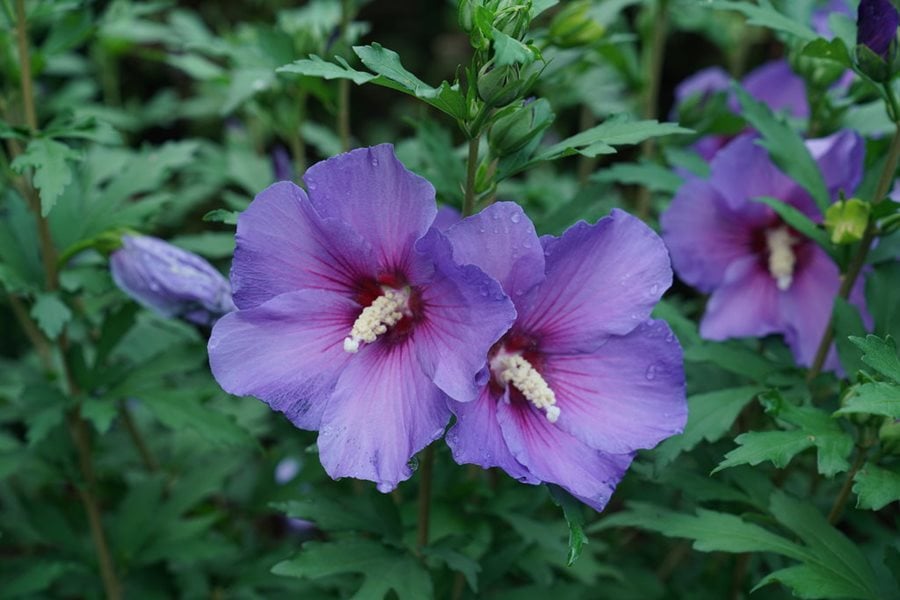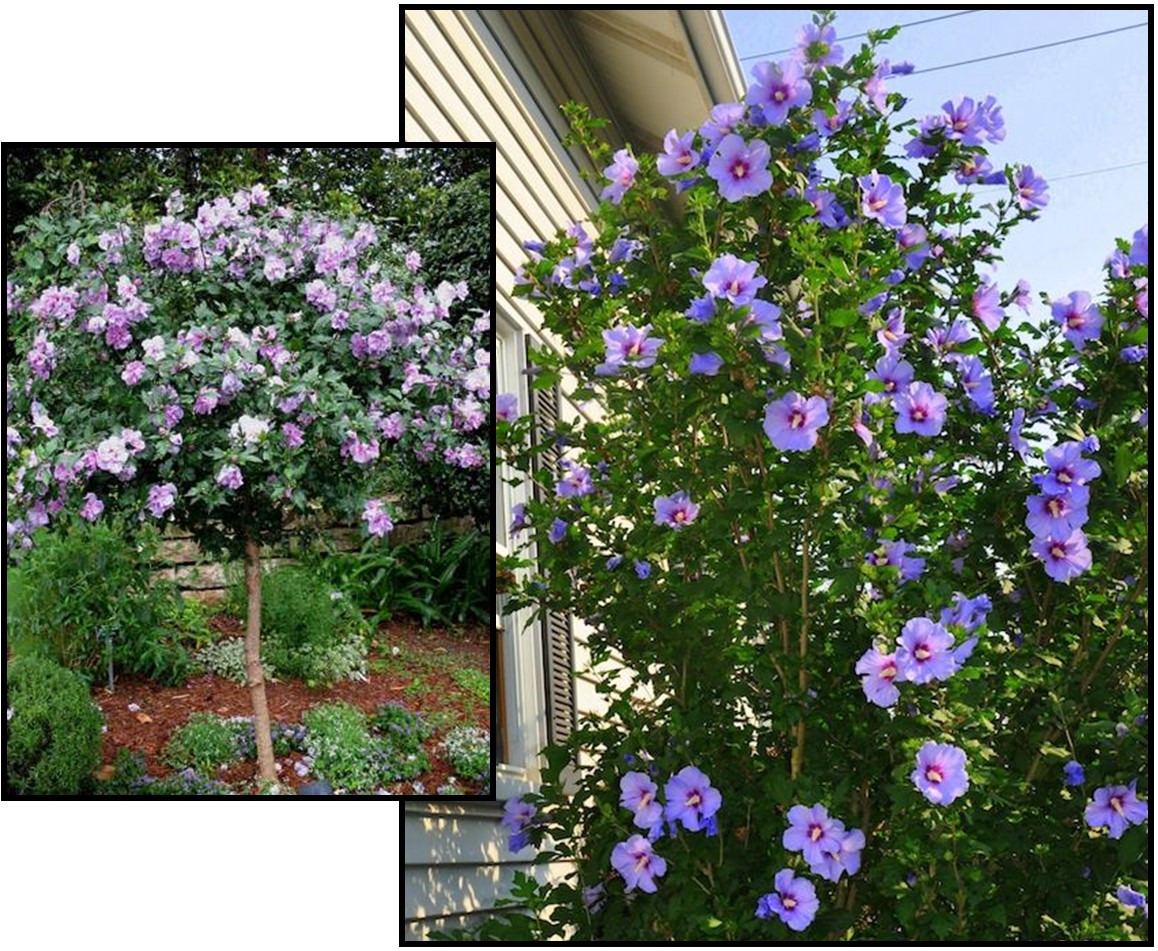The Striking Purple Rose Of Sharon: A Musthave For Your Garden
The Striking Purple Rose of Sharon: A Must-Have for Your Garden
The rose of Sharon is a beautiful and versatile shrub that can add a touch of elegance to any garden. With its striking purple blooms, it's sure to turn heads all summer long. But the purple rose of Sharon is more than just a pretty face. It's also relatively easy to care for, making it a great choice for even the most novice gardener.
In this blog post, we'll take a closer look at the purple rose of Sharon. We'll discuss its appearance, growing requirements, and care tips. We'll also share some of the benefits of adding this stunning shrub to your garden.
Appearance
The purple rose of Sharon is a deciduous shrub that can grow up to 10 feet tall and wide. It has large, maple-shaped leaves that are dark green in color. In the summer, it produces showy clusters of purple flowers. The flowers can be single or double, and they can range in color from light lavender to deep purple.
The purple rose of Sharon is a very attractive shrub, and it can be used in a variety of ways in the garden. It can be planted as a standalone specimen, or it can be used to create a hedge or screen. It can also be used to add color to a mixed border or patio planting.
Growing Requirements
The purple rose of Sharon is relatively easy to grow. It prefers full sun, but it can tolerate partial shade. It also prefers moist, well-drained soil. The purple rose of Sharon is drought-tolerant once it is established, but it will benefit from regular watering during the summer months.
The purple rose of Sharon is not as cold-hardy as some other shrubs, so it is best suited for growing in USDA zones 5-9. However, there are some varieties that are hardy in zones 3-8.
Care Tips
The purple rose of Sharon is a low-maintenance shrub, but it does require some basic care. In the spring, you should fertilize the shrub with a balanced fertilizer. You should also prune the shrub in the spring to remove any dead or damaged branches.
The purple rose of Sharon is not susceptible to many pests or diseases. However, it can be affected by aphids, scale insects, and powdery mildew. If you notice any problems, you can treat them with an insecticidal soap or fungicide.
Benefits of Planting a Purple Rose of Sharon
There are many benefits to planting a purple rose of Sharon in your garden. Here are just a few:
- Beautiful flowers: The purple rose of Sharon produces stunning clusters of purple flowers that will add color to your garden all summer long.
- Easy to care for: The purple rose of Sharon is a relatively easy shrub to care for. It is drought-tolerant and can tolerate a variety of soil conditions.
- Versatile: The purple rose of Sharon can be used in a variety of ways in the garden. It can be planted as a standalone specimen, or it can be used to create a hedge or screen. It can also be used to add color to a mixed border or patio planting.
- Attracts pollinators: The purple rose of Sharon is a popular plant for pollinators, such as bees and butterflies. By planting a purple rose of Sharon, you can help to support these important insects.
Conclusion
The purple rose of Sharon is a beautiful and versatile shrub that can add a touch of elegance to any garden. It is relatively easy to care for and can be grown in a variety of climates. If you are looking for a shrub that will provide you with years of enjoyment, the purple rose of Sharon is a great choice.
If you're looking for a beautiful and easy-care shrub to add to your landscape, look no further than the purple rose of Sharon. This versatile plant can be grown in a variety of conditions, and it produces stunning blooms in a range of colors, including purple.
One of the most popular purple rose of Sharon varieties is Purple Pillar®. As its name suggests, this plant grows in a narrow columnar shape, making it ideal for small spaces or as a privacy hedge. Purple Pillar® blooms in late summer and fall, and its flowers are a deep, rich purple color with a red center.
To learn more about purple rose of Sharon, including care tips and planting instructions, I recommend visiting Garden Wiki. This website has a wealth of information on all aspects of growing this beautiful plant.
FAQ of purple rose of sharon
Question 1: How do I take care of a purple rose of Sharon?
Answer: Purple rose of Sharon is a relatively easy plant to care for. It is tolerant of a wide range of soil conditions, but it prefers well-drained soil. It is also drought-tolerant once established, but it will benefit from regular watering during the first year after planting. To encourage flowering, fertilize your purple rose of Sharon in early spring with a balanced fertilizer. Prune your purple rose of Sharon in late winter or early spring to remove any dead or damaged branches.
Question 2: What are the different colors of purple rose of Sharon?
Answer: Purple rose of Sharon comes in a variety of colors, including white, pink, lavender, blue, and bicolors. The color of the flowers can vary depending on the variety of purple rose of Sharon, the climate in which it is grown, and the amount of sunlight it receives.
Question 3: How long does it take for a purple rose of Sharon to reach full size?
Answer: Purple rose of Sharon typically reaches full size in about 2 years. However, the exact size of the plant will vary depending on the variety and the growing conditions.
Question 4: How do I propagate purple rose of Sharon?
Answer: Purple rose of Sharon can be propagated by cuttings or by division. To propagate by cuttings, take 6-inch cuttings from healthy, new growth in early summer. Dip the cuttings in rooting hormone and plant them in a well-drained potting mix. Keep the cuttings moist and in a warm location until they have rooted, which can take several weeks. To propagate by division, dig up a mature purple rose of Sharon plant in early spring or fall. Use a sharp spade to divide the plant into several sections, each with its own roots. Replant the divisions in a sunny location with well-drained soil.
Question 5: Is purple rose of Sharon invasive?
Answer: Purple rose of Sharon is not considered to be an invasive plant. However, it can be aggressive and spread quickly if not properly cared for. To prevent purple rose of Sharon from becoming invasive, plant it in a location where it has plenty of space to grow. Prune it regularly to control its size and shape.
Image of purple rose of sharon
- Image 1: A large, full bush of purple rose of Sharon flowers in bloom. The flowers are a deep purple color with white centers. The leaves are dark green and the stems are brown.

- Image 2: A close-up of a single purple rose of Sharon flower. The flower is a deep purple color with a white center. The petals are slightly ruffled and the stamen are yellow.

- Image 3: A row of purple rose of Sharon trees in bloom. The trees are about 10 feet tall and the flowers are hanging down from the branches. The flowers are a deep purple color with white centers.

- Image 4: A purple rose of Sharon flower in a vase. The flower is a deep purple color with a white center. The petals are slightly ruffled and the stamen are yellow. The leaves are dark green and the stems are brown.

- Image 5: A purple rose of Sharon flower in a garden. The flower is a deep purple color with a white center. The petals are slightly ruffled and the stamen are yellow. The leaves are dark green and the stems are brown. The flower is surrounded by other flowers in the garden.

Post a Comment for "The Striking Purple Rose Of Sharon: A Musthave For Your Garden"